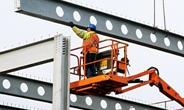Steel Markets

Construction Employment Increases in 43 States and DC in Past Year
Written by Sandy Williams
March 17, 2015
Continued increases in construction employment are at risk if Congress does not address infrastructure funding, says the Associated General Contractors of America. Increased regulation is also “adding costly new paperwork and reporting requirements for employers” without addressing problems. The report by AGC is reprinted below:
Construction firms added jobs in 43 states and the District of Columbia between January 2014 and January 2015 while construction employment increased in 31 between December and January, according to an analysis today of Labor Department data by the Associated General Contractors of America. Association officials noted that further construction gains could be undermined if Congress and the administration fail to address infrastructure funding challenges growing regulatory burdens.
“Most of the country experienced a welcome rebound in construction employment last year,” said Ken Simonson, the association’s chief economist. “Yet it is unclear how public sector demand and new regulatory requirements will overshadow relatively robust private-sector demand.”
Texas added more new construction jobs (49,600 jobs, 7.9 percent) between January 2014 and January 2015 than any other state. Other states adding a high number of new construction jobs for the past 12 months included California (37,800 jobs, 5.7 percent), Florida (31,800 jobs, 8.3 percent), Washington (17,300 jobs, 11.1 percent) and New York (16,400 jobs, 5.0 percent). North Dakota (13.4 percent, 4,300 jobs) added the highest percentage of new construction jobs during the past year, followed by Idaho (12.7 percent, 4,400 jobs), Washington and Colorado (9.8 percent, 13,500 jobs).
Seven states shed construction jobs during the past 12 months. Mississippi lost the highest percentage and total number of jobs (-6,600 jobs, -12.7 percent). Other states that lost a high number of jobs include Indiana (-1,900 jobs, -1.6 percent), West Virginia (-700 jobs, -2.1 percent), Minnesota (-700 jobs, -0.7 percent) and Maine (-500 jobs, -1.9 percent.)
Thirty-one states added construction jobs between December and January. California (11,700 jobs, 1.7 percent) added the most jobs, followed by New Jersey (6,100 jobs, 4.2 percent), Michigan (5,900 jobs, 4.1 percent) and Florida (5,500 jobs, 1.3 percent). Arkansas (4.9 percent, 2,300 jobs) had the highest percentage increase for the month, followed by Vermont (4.8 percent, 700 jobs), Idaho (4.5 percent, 1,700 jobs) and New Jersey.
Nineteen states lost construction jobs for the month, while construction employment was unchanged in the District of Columbia. Louisiana (-4,100 jobs, -2.8 percent) lost the highest percentage and the most construction jobs between December and January. Other states experiencing large monthly declines in total construction employment included Indiana (-2,800 jobs, -2.3 percent), Georgia (-2,800 jobs, -1.8 percent) and Illinois (-2,500 jobs, -1.2 percent). Other states with large monthly declines in the percentage of construction employment included Maine (-2.7 percent, -700 jobs) and Wyoming (-2.5 percent, -600 jobs.)
Association officials said they were worried about the Obama administration’s efforts to issue a host of new regulations during the remainder of the President’s terms. They noted that many of these rules do little to address the problems they were ostensibly intended to address while adding costly new paperwork and reporting requirements for employers. Coupled with Washington seeming inability to find ways to fund aging road, bridge and other infrastructure repairs, officials warned growing red tape could undermine future employment gains.
“If Congress and the Obama administration are serious about wanting to help the middle class, they will need to find a way to fund infrastructure investments over the long term,” said Stephen E. Sandherr, the association’s chief executive officer. “And the administration needs to stop trying to impose its failed legislative agenda via regulatory fiat.”

Sandy Williams
Read more from Sandy WilliamsLatest in Steel Markets

CMC looks beyond Arizona micro-mill woes to long-term viability of construction mart
Despite the economic and geopolitical upheaval of the last five years, CMC President and CEO Peter Matt points out that the construction market has been an essential element of the way forward.

US importers face stricter rules under revamped S232 tariffs
“CBP expects full compliance from the trade community for accurate reporting and payment of the additional duties. CBP will take enforcement action on non-compliance," the agency said in a March 7 bulletin.

Steel exports rebound in January
US steel exports recovered to a five-month high in January after having fallen to a two-year low in December. This growth follows four consecutive months of declining exports.

Construction spending drops marginally in January
Construction spending edged down slightly in January, slipping for the first time in four months. The US Census Bureau estimated spending at a seasonally adjusted annual rate of $2,196 billion in January, down 0.2% from December’s downward revised rate. The January figure is 3.3% higher than a year ago. January’s result, despite the slight erosion, […]

HVAC equipment shipments slow in December but strong annually
Shipments of heating and cooling equipment in the US fell to an 11-month low in December, according to the latest data released by the Air-Conditioning, Heating, and Refrigeration Institute (AHRI).
